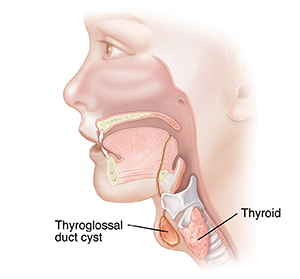A
B
C
D
E
F
G
H
I
J
K
L
M
N
O
P
Q
R
S
T
U
V
W
X
Y
Z
Click a letter to see a list of medical procedures beginning with that letter.
Click 'Back to Intro' to return to the beginning of this section.
Thyroglossal Duct Cyst in Children
What is a thyroglossal duct cyst in children?
A thyroglossal duct cyst is a pocket in the front part of neck that is filled with fluid. A child may be born with this cyst. It is formed from leftover tissue from the development of the thyroid gland when an embryo was forming. The thyroid gland is located in the front of the neck. It is part of the hormone-producing glands called the endocrine system.
Although the cyst is present at birth, it is often not found until a child is at least age 2. Often a healthcare provider finds a thyroglossal cyst when a child gets an upper respiratory infection.

What causes a thyroglossal duct cyst in a child?
The thyroid gland forms during the early stages in the development of an embryo. It begins at the base of the tongue and moves down the neck through a channel or tube (thyroglossal duct). This duct normally goes away once the thyroid reaches its final position in the neck. Sometimes part of the duct remains. This leaves a pocket called a cyst.
What are the symptoms of a thyroglossal duct cyst in a child?
Symptoms can occur a bit differently in each child. The most common include:
-
A small, soft, round lump in the center front of the neck
-
Tenderness, redness, and swelling of the lump, if infected
-
Trouble swallowing or breathing
The symptoms of a thyroglossal duct cyst can seem like other health conditions. Make sure your child sees their healthcare provider for a diagnosis.
How is a thyroglossal duct cyst diagnosed in a child?
A thyroglossal cyst is often diagnosed when your child’s healthcare provider examines your child. The provider will often advise that your child see an ear, nose, and throat doctor (ENT or otolaryngologist). Or the provider may refer you to another healthcare provider with experience in thyroglossal duct cysts. Your child may need tests such as:
-
Blood tests. These tests check the thyroid gland function.
-
Ultrasound exam. Sound waves are used to check the cyst and thyroid gland.
-
CT scan of the neck. X-rays and a computer are used to take detailed images of the neck, including the cyst and thyroid gland. Contrast dye is used to get better images.
-
Fine needle aspiration. A small needle is used to remove cells from the cyst for diagnosis.
How is a thyroglossal duct cyst treated in a child?
Treatment will depend on your child’s symptoms, age, and general health. It will also depend on how severe the condition is.
Your child’s healthcare provider will regularly check your child’s cyst. Treatment may include:
-
Antibiotic medicine
-
Inserting a needle into the cyst and draining it, if antibiotic medicine doesn’t get rid of the infection
-
Cutting out the cyst and some nearby tissue (surgical excision). This is the most common treatment.
-
Injecting a substance to remove the cyst, if a child can’t have surgery
What are possible complications of a thyroglossal duct cyst in a child?
Complications of a thyroglossal duct cyst may include:
-
Blocking the upper airway
-
Serious or returning infection
-
Presence of cancer cells, but this is uncommon
Key points about a thyroglossal duct cyst in children
-
A thyroglossal duct cyst is a pocket in the front part of neck that is filled with fluid. A child is born with this cyst.
-
It is formed from leftover tissue from the development of the thyroid gland when an embryo is forming.
-
Although the cyst is present at birth, it is often not found until a child is at least age 2.
-
A thyroglossal duct cyst is often diagnosed when your child's healthcare provider examines your child.
-
Treatment may include antibiotic medicine to treat any infection or surgery to remove the cyst.
Next steps
Tips to help you get the most from a visit to your child’s healthcare provider:
-
Know the reason for the visit and what you want to happen.
-
Before your visit, write down questions you want answered.
-
At the visit, write down the name of a new diagnosis, and any new medicines, treatments, or tests. Also write down any new instructions your provider gives you for your child.
-
Know why a new medicine or treatment is prescribed and how it will help your child. Also know what the side effects are.
-
Ask if your child’s condition can be treated in other ways.
-
Know why a test or procedure is recommended and what the results could mean.
-
Know what to expect if your child does not take the medicine or have the test or procedure.
-
If your child has a follow-up appointment, write down the date, time, and purpose for that visit.
-
Know how you can contact your child’s provider after office hours. This is important if your child becomes ill and you have questions or need advice.
Online Medical Reviewer:
Rita Sather RN
Online Medical Reviewer:
Sumana Jothi MD
Online Medical Reviewer:
Tara Novick BSN MSN
Date Last Reviewed:
1/1/2023
© 2000-2025 The StayWell Company, LLC. All rights reserved. This information is not intended as a substitute for professional medical care. Always follow your healthcare professional's instructions.